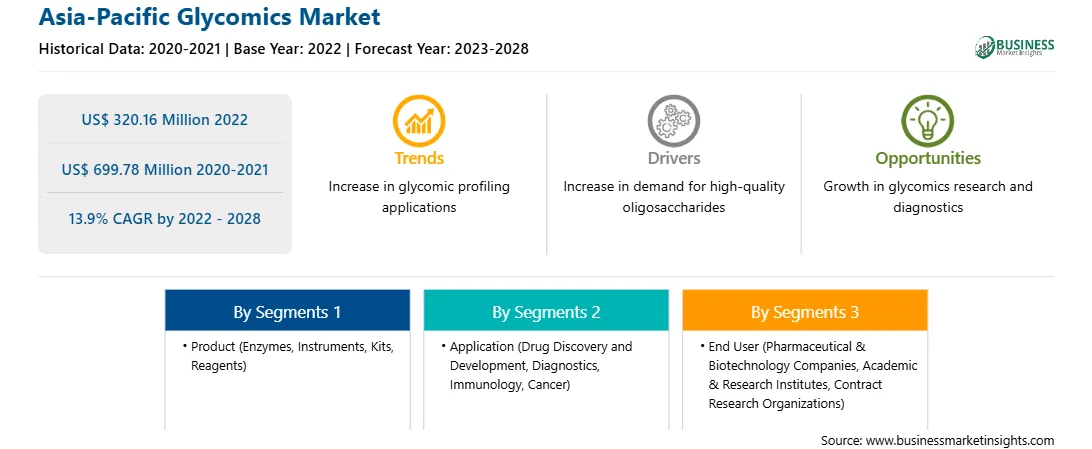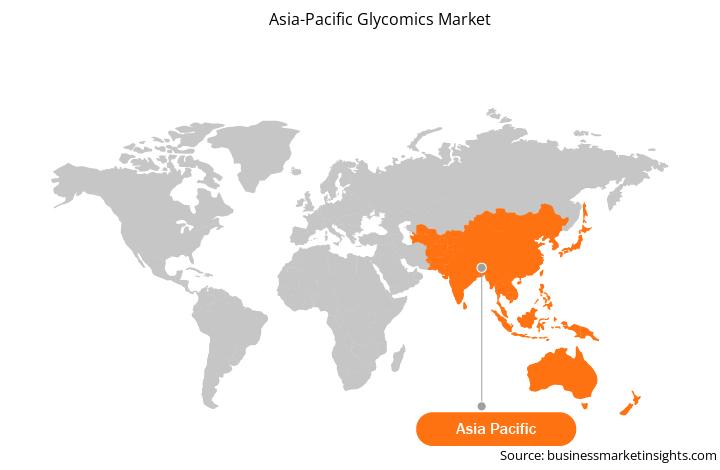The APAC glycomics market is expected to grow from US$ 320.16 million in 2022 to US$ 699.78 million by 2028; it is estimated to grow at a CAGR of 13.9% from 2022 to 2028.
By enhancing the characterization of molecules crucial to the development of diseases, glycomics has the potential to pave the way for innovative treatment approaches. It can be a substantial addition to technologies used in genomes and proteomics. Comparative glycomics will be essential for identifying the glycans that cause disease, and studies will provide light on the relationship between clinical outcomes and glycomic anomalies. Immunohistochemistry (IHC), Liquid Chromatography-Mass Spectrometry (LC-MS), and high-throughput fluorescence flow cytometry have long been used to distinguish cell populations using glycoproteins. These are the important technologies utilized to advance glycomics. By separating several glycoprotein isoforms from a single protein species, LC-MS can provide structural details about glycoconjugates. Unbiased surveys of cellular proteomes are now available due to high-throughput MS-based proteomics, and the method is swiftly applied to glycomics. Structural reference databases are quickly emerging to close the gap between the variety and complexity of glycan structures. Identification of disease-related glycoconjugates by LC-MS, which employs antibody-based capture to view glycoconjugate expression with cell-staining or fluorescence, can be used to further assess or validate IHC. Targeting complete cells rather than tissue fragments, immunocytochemistry (ICC) reveals glycoprotein expression patterns at the cellular level utilizing the same imaging techniques as IHC. It will be possible to see new aspects of glycomics, such as a more thorough characterization of metabolic junctions and pathways, by modifying IHC and ICC to concentrate on additional glycoconjugates, such as glycolipids. Tandem or multi-technology procedures, such as MS-IHC, will provide labs with more analytical ability to handle the complexity of glycoconjugates and improve glycoconjugate diagnosis. The clinical applications of glycomics are catching up to those of genomics and proteomics due to the development of new high-throughput methods to study the structure and expression of glycans and ongoing innovation in glycan biomarkers and therapies. Integrating glycomics will revolutionize precision medicine into an extensive omics strategy, providing new information on the interactions between genes, proteins, and glycans. The combination of omics data with digital health platforms has the potential to improve clinical trials and aid in the creation of more complex knowledge of illness among researchers and doctors. Although these and other scientific discoveries are making their way from the lab to the clinic, widespread acceptance of glycomics and personalized medicine will necessitate significant changes in regulatory and reimbursement procedures and legislative privacy laws. Thus, customized healthcare challenges will be met and overcome with the assurance that the research behind glycomic medicine is decent and that the practice of medicine that it informs is evidence-based. So, new tools in glycomics research are expected to drive the market in the coming years.
With the new features and technologies, vendors can attract new customers and expand their footprints in emerging markets. This factor is likely to drive the APAC glycomics market. The APAC glycomics market is expected to grow at a good CAGR during the forecast period.
APAC Glycomics Market Revenue and Forecast to 2028 (US$ Million)
Strategic insights for the Asia-Pacific Glycomics provides data-driven analysis of the industry landscape, including current trends, key players, and regional nuances. These insights offer actionable recommendations, enabling readers to differentiate themselves from competitors by identifying untapped segments or developing unique value propositions. Leveraging data analytics, these insights help industry players anticipate the market shifts, whether investors, manufacturers, or other stakeholders. A future-oriented perspective is essential, helping stakeholders anticipate market shifts and position themselves for long-term success in this dynamic region. Ultimately, effective strategic insights empower readers to make informed decisions that drive profitability and achieve their business objectives within the market. The geographic scope of the Asia-Pacific Glycomics refers to the specific areas in which a business operates and competes. Understanding local distinctions, such as diverse consumer preferences (e.g., demand for specific plug types or battery backup durations), varying economic conditions, and regulatory environments, is crucial for tailoring strategies to specific markets. Businesses can expand their reach by identifying underserved areas or adapting their offerings to meet local demands. A clear market focus allows for more effective resource allocation, targeted marketing campaigns, and better positioning against local competitors, ultimately driving growth in those targeted areas.Asia-Pacific Glycomics Strategic Insights

Asia-Pacific Glycomics Report Scope
Report Attribute
Details
Market size in 2022
US$ 320.16 Million
Market Size by 2028
US$ 699.78 Million
Global CAGR (2022 - 2028)
13.9%
Historical Data
2020-2021
Forecast period
2023-2028
Segments Covered
By Product
By Application
By End User
Regions and Countries Covered
Asia-Pacific
Market leaders and key company profiles
Asia-Pacific Glycomics Regional Insights

APAC Glycomics Market Segmentation
The APAC glycomics market is segmented based on product, application, end user, and country. Based on product, the APAC glycomics market is segmented into enzymes, instruments, kits, and reagents. The enzymes segment dominated the market in 2022. The enzymes segment is further segmented into glycosidases, glycosyl transferases, sialyltransferases, neuraminidases, and others. The instruments segment is also segmented into mass spectrometers, MALDI-TOF, HPLC, lectin arrays, antibody arrays, and others. The kits segment is categorized into glycan release kits, glycan labeling kits, glycan purification kits, and others. The reagents segment is segmented into oligosaccharides, monosaccharides, glycoproteins, and others.
In terms of application, the APAC glycomics market is segmented into drug discovery and development, diagnostics, immunology, cancer, and others. The drug discovery and development segment dominated the market in 2022. Based on end user, the APAC glycomics market is segmented into pharmaceutical & biotechnology companies, academic & research institutes, and contract research organizations. The pharmaceutical & biotechnology companies segment dominated the market in 2022. Based on country, the APAC glycomics market has been categorized into China, India, Japan, South Korea, Australia, and the Rest of APAC. China dominated the market in 2022.
Agilent Technologies, Inc.; Bruker Corporation; MERCK KGaA; New England Biolabs; S-BIO (Sumitomo Bakelite Co., Ltd.); Shimadzu Corporation; Takara Bio Inc.; Thermo Fisher Scientific Inc.; and Waters Corporation are among the leading companies in the APAC glycomics market.
The Asia-Pacific Glycomics Market is valued at US$ 320.16 Million in 2022, it is projected to reach US$ 699.78 Million by 2028.
As per our report Asia-Pacific Glycomics Market, the market size is valued at US$ 320.16 Million in 2022, projecting it to reach US$ 699.78 Million by 2028. This translates to a CAGR of approximately 13.9% during the forecast period.
The Asia-Pacific Glycomics Market report typically cover these key segments-
The historic period, base year, and forecast period can vary slightly depending on the specific market research report. However, for the Asia-Pacific Glycomics Market report:
The Asia-Pacific Glycomics Market is populated by several key players, each contributing to its growth and innovation. Some of the major players include:
The Asia-Pacific Glycomics Market report is valuable for diverse stakeholders, including:
Essentially, anyone involved in or considering involvement in the Asia-Pacific Glycomics Market value chain can benefit from the information contained in a comprehensive market report.